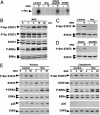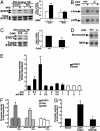Cyclin-dependent kinase 5 phosphorylates signal transducer and activator of transcription 3 and regulates its transcriptional activity
- PMID: 15096606
- PMCID: PMC404113
- DOI: 10.1073/pnas.0307606100
Cyclin-dependent kinase 5 phosphorylates signal transducer and activator of transcription 3 and regulates its transcriptional activity
Abstract
The activity of cyclin-dependent kinase 5 (Cdk5) depends on the association with one of its activators, p35 and p39, which are prominently expressed in the nervous system. Studies on the repertoire of protein substrates for Cdk5 have implicated the involvement of Cdk5 in neuronal migration and synaptic plasticity. Our recent analysis of the sequence of signal transducer and activator of transcription (STAT)3, a key transcription factor, reveals the presence of potential Cdk5 phosphorylation site. We report here that the Cdk5/p35 complex associates with STAT3 and phosphorylates STAT3 on the Ser-727 residue in vitro and in vivo. Intriguingly, whereas the Ser phosphorylation of STAT3 can be detected in embryonic and postnatal brain and muscle of wild-type mice, it is essentially absent from those of Cdk5-deficient embryos. In addition, treatment of cultured myotubes with neuregulin enhances the Ser phosphorylation of STAT3 and transcription of STAT3 target genes, such as c-fos and junB, in a Cdk5-dependent manner. Both the DNA-binding activity of STAT3 and the transcription of specific target genes, such as fibronectin, are reduced in Cdk5-deficient muscle. Taken together, these results reveal a physiological role of Cdk5 in regulating STAT3 phosphorylation and modulating its transcriptional activity.
Figures




References
-
- Dhavan, R. & Tsai, L.-H. (2001) Nat. Rev. Mol. Cell Biol. 2, 749-759. - PubMed
-
- Lew, J., Huang, Q. Q., Qi, Z., Winkfein, R. J., Aebersold, R., Hunt, T. & Wang, J. H. (1994) Nature 371, 423-426. - PubMed
-
- Tsai, L.-H., Delalle, I., Caviness, V. S., Jr., Chae, T. & Harlow, E. (1994) Nature 371, 419-423. - PubMed
-
- Tang, D., Yeung, J., Lee, K. Y., Matsushita, M., Matsui, H., Tomizawa, K., Hatase, O. & Wang, J. H. (1995) J. Biol. Chem. 270, 26897-26903. - PubMed
-
- Fu, A. K., Fu, W.-Y., Cheung, J., Tsim, K. W., Ip, F. C., Wang, J. H. & Ip, N. Y. (2001) Nat. Neurosci. 4, 374-381. - PubMed
Publication types
MeSH terms
Substances
LinkOut - more resources
Full Text Sources
Other Literature Sources
Molecular Biology Databases
Research Materials
Miscellaneous

